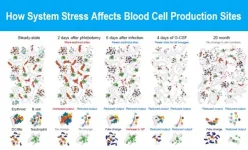Current figures show that around one in six pregnant women worldwide are affected by a special form of diabetes known as gestational diabetes. According to the Robert Koch Institute, 63,000 women in Germany were affected by the disease in 2021, and the trend is increasing.
These numbers are alarming because excessively high blood sugar levels during pregnancy are associated with negative consequences for mother and child. This increases the risk of affected women developing type 2 diabetes later on and their children have a higher risk of developing metabolic disorders and being overweight.
Long-Term Effect of Metformin on Offspring is Unclear
For several years, the placenta-crossing oral antidiabetic agent metformin has been increasingly gaining importance as an alternative to insulin administration when lifestyle changes show no success during the treatment of gestational diabetes. However, there are currently only a few studies on the long-term effects of metformin on the health of offspring. It is known that metformin has an impact on the AMPK signaling pathway, which regulates the networking of nerve cells during brain development.
The interdisciplinary team of DIfE researchers led by Junior Research Group Leader Dr. Rachel Lippert therefore grappled with two central questions: Is metformin treatment only beneficial for the mother or also the child? And does metformin treatment lead to long-term negative physiological changes in the offspring, especially in connection with the development of neuronal circuits in the hypothalamus, a critical region in the regulation of energy homeostasis?
Mouse Models Shed some Light
To answer the key questions, the researchers used two mouse models to represent the main causes of gestational diabetes:
severe obesity of the mother before pregnancy and excessive weight gain during pregnancy. These metabolic states were achieved by means of different feeding patterns, with the mice receiving either a high-fat or control diet. The antidiabetic treatment of female mice and their offspring took place during the lactation period as this corresponds to the third trimester of a human pregnancy in terms of brain development.
Treatment involved insulin, metformin, or a placebo, whereby the dosage was based on standard human treatments. The research team collected data on the body weight of the mice, analyzed various metabolic parameters and hormones, and examined molecular signaling pathways in the hypothalamus.
Maternal Metabolic State is Crucial
“As a result of antidiabetic treatment in the early postnatal period, we were able to identify alterations in the weight gain and hormonal status of the offspring, which were critically dependent on the metabolic state of the mother,” explains Lippert. Furthermore, sex-specific changes in hypothalamic AMPK signaling in response to metformin exposure were also observed. Together with the metformin-induced shift in the examined hormone levels, the results indicate that the maternal metabolic state must be taken into account before starting the treatment of gestational diabetes.
Focusing on Prevention
According to Rachel Lippert, treatment of gestational diabetes in future could entail developing a medication that is available for all and does not cross the placenta. “Given the increasing prevalence, education about gestational diabetes and preventive measures are of vital importance. If we can find a way to manage lifestyle and diet more proactively, we are in a better position to exploit the potential of gestational diabetes treatment,” says Lippert.
Original publication:
Lídia Cantacorps, Jiajie Zhu, Selma Yagoub, Bethany M. Coull, Joanne Falck, Robert A. Chesters, Katrin Ritter, Miguel Serrano-Lope, Katharina Tscherepentschuk, Lea-Sophie Kasch, Maya Paterson, Paula Täger, David Baidoe-Ansah, Shuchita Pandey, Carla Igual-Gil, Annett Braune, Rachel N. Lippert. Developmental metformin exposure does not rescue physiological impairments derived from early exposure to altered maternal metabolic state in offspring mice. Molecular Metabolism 2023 Dec 23; doi: 10.1016/j.molmet.2023.101860.
Background Information
Metformin is an orally taken antidiabetic agent that lowers blood sugar levels by inhibiting glucose production in the liver and increasing the insulin sensitivity of the cells. It is often prescribed as a first-line treatment for people with type 2 diabetes. Metformin is either used alone or in combination with other oral antidiabetic drugs or insulin preparations. The European Medicines Agency approved metformin for treatment during pregnancy in March 2022.
Funding
This study was funded by the German Research Foundation (DFG) under the Excellence Strategy of the German federal and state governments (EXC-2049–390688087, NeuroCure, RNL) and by the German Center for Diabetes Research (DZD) (82DZD03D2Y and 82DZD03D03, RNL).
Scientific Contact
Dr. Rachel Lippert
Head of the Junior Research Group Neural Circuits
Phone.: +49 33 200 88 - 2470
E-Mail: rachel.lippert@dife.de
Press Contact
Public Relations
Phone: +49 33200 88-2335
E-Mail: presse@dife.de
The German Institute of Human Nutrition (DIfE) is a member of the Leibniz Association. It investigates the causes of diet-related diseases in order to develop new strategies for prevention and therapy and to provide dietary recommendations. Its research focus includes the causes and consequences of the metabolic syndrome, which is a combination of obesity, high blood pressure, insulin resistance and lipid metabolism disorder, as well as the role of diet in healthy aging and the biological basis of food choices and eating habits. In addition, DIfE is a partner of the German Center for Diabetes Research (DZD), which was founded in 2009 and has since been funded by the BMBF. The DIfE is a member of the Leibniz Association. It investigates the causes of diet-related diseases in order to develop new strategies for prevention and therapy and to provide dietary recommendations. Its research focus includes the causes and consequences of the metabolic syndrome, which is a combination of obesity, high blood pressure, insulin resistance and lipid metabolism disorder, as well as the role of diet in healthy aging and the biological basis of food choices and eating habits. In addition, DIfE is a partner of the German Center for Diabetes Research (DZD), which was founded in 2009 and has since been funded by the BMBF. www.dife.de/en
The German Center for Diabetes Research (DZD) is a national association that brings together experts in the field of diabetes research and combines basic research, translational research, epidemiology and clinical applications. The aim is to develop novel strategies for personalized prevention and treatment of diabetes. Members are Helmholtz Munich – German Research Center for Environmental Health, the German Diabetes Center in Düsseldorf, the German Institute of Human Nutrition in Potsdam-Rehbrücke, the Paul Langerhans Institute Dresden of Helmholtz Munich at the University Medical Center Carl Gustav Carus of the TU Dresden and the Institute for Diabetes Research and Metabolic Diseases of Helmholtz Munich at the Eberhard-Karls-University of Tuebingen together with associated partners at the Universities in Heidelberg, Cologne, Leipzig, Lübeck and Munich. www.dzd-ev.de/en
END






